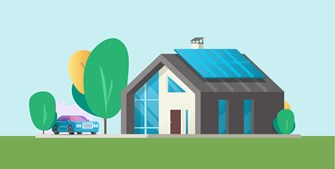If you’re looking to live a more sustainable lifestyle, why not start at home? Creating a sustainable home is easier than you might think. By making changes to your daily household activities like heating or cooling your home, cooking, and washing clothes, you can:
- Conserve energy and water
- Create a healthier home
- Reduce your carbon footprint
- Save money on your utility bills
- Potentially increase your property value
Not sure where to start? We’ve assembled a list of 10 home sustainability tips to get you started:
- LED lighting: Replace conventional light bulbs with LED lighting. LED bulbs are extremely energy efficient, long-lasting and have a lower environmental impact. They can produce light that feels “warm” (yellow hue, more relaxing to the eyes) or “cool” (white hue, better for practical application). When compared to conventional lighting, LED bulbs reduce energy consumption by more than 80 percent and can last 25 times longer.
- Energy efficient appliances: Most residential energy consumption comes from appliances, such as furnaces, air conditioners, refrigerators, washers and dryers. Investing in energy-efficient appliances produces fewer greenhouse gas emissions, and can also help you save money and add comfort to your home.
- Solar panels: Converting sunlight into energy is an efficient, cost-effective and cleaner way to generate electricity for your home. Unlike traditional energy that relies on fossil fuels, solar power is a clean energy. Homeowners who install solar panels, or utilize other clean energy resources, may also be eligible for a tax credit on their income taxes through December 31, 2021.
- Water conservation: The average American household uses 300 gallons of water a day. There are many simple ways to reduce water consumption. Establish habits that save water, such as only running the dishwasher when it’s full, turning off the faucet when brushing your teeth and reducing shower time. Make sure your faucets and toilets are free of any leaks. Installing low-flow water products and repurposing water (like reserving pasta water to water plants) are other beneficial ways to conserve water.
- Insulation: Reduce heat loss and gain by insulating your home’s walls, ceilings, and between floors and crawl spaces. By reducing the need to heat or cool your home, you also reduce greenhouse gas emissions. One of the most eco-friendly insulations is aerogel, which is more than 90 percent air. It can be rather expensive, so you may want to opt for other natural and sustainable alternatives such as cellulose, wool and cotton.
- Windows: Windows account for 25 to 30 percent of residential heat gain and loss. The window frame, type of glass and installation all contribute to efficiency. Inspect the inside and outside of windows in your home for any air leaks and apply weather stripping or caulking where needed. If you decide it’s time to replace your windows, be sure to consult with a professional about options that are best for your climate.
- Landscaping: Properly selected and placed plants can promote water and energy conservation, improve air and water quality, and create a healthy habitat for local wildlife and pollinators. Incorporating organic matter such as mulch and compost can minimize or eliminate the use of harmful chemical fertilizers and pesticides. For more information about creating a sustainable yard, click here.
- Recycle and reuse: Staying committed to a recycling routine is an easy and efficient way to contribute to eradicating toxic waste and environmental pollutants. Reusing disposable items like gift bags and paper products can also create less waste.
- Household products: Some cleaning products contain hazardous chemicals, including volatile organic compounds (VOCs), such as benzene, ethylene, formaldehyde and methylene chloride. When sprayed, VOCs emit gaseous pollutants into the air, and if used in sinks, tubs and toilets, can also harm the water supply. Additionally, these products are often packaged in non-recyclable plastics or aerosol cans that create additional waste. Look for products that are non-toxic, biodegradable and packaged from recycled materials. For help choosing more sustainable products, click here.
- Paint and building materials: When remodeling or renovating your home, you can save money by repurposing items and materials. Doors, cabinetry, molding, light fixtures and furniture can all be refurbished, reupholstered or repurposed for ongoing use. You can also use reclaimed building materials like wood, bricks and glass to create stylish design features. Choose paint, glue and sealants that are nontoxic and have little or no VOCs.
Before you start making a sustainability plan, it’s helpful to conduct a self-assessment or professional energy audit. Be sure to factor in your home’s location and your budget. While there are many options to choose from, selecting those that are right for you will warrant greater success and longevity. If you are considering purchasing a new sustainable home, Old Republic Title is here to help with all your title and escrow needs. To learn more about the homebuying and closing process, visit Old Republic Title’s Homeowner Resources page.




